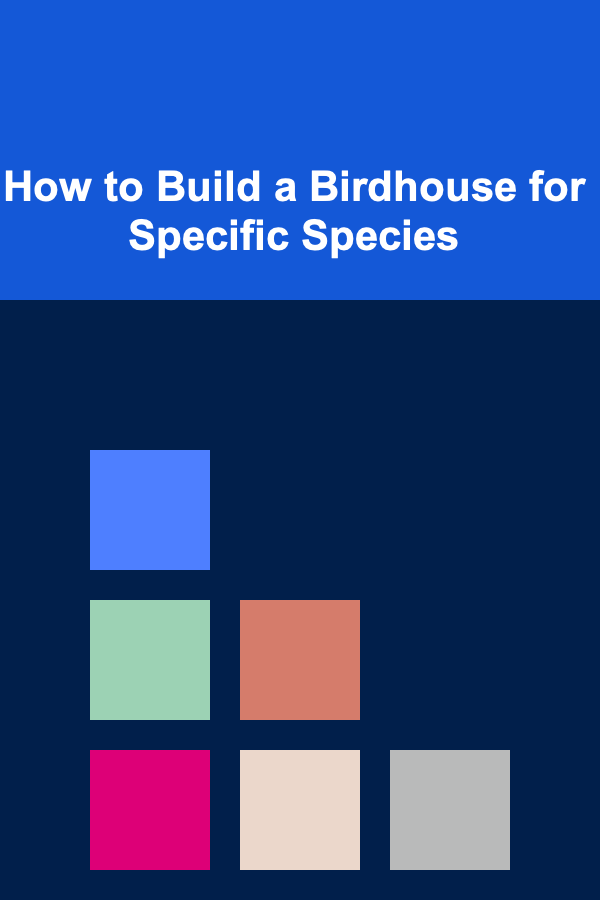
How to Build a Birdhouse for Specific Species
ebook include PDF & Audio bundle (Micro Guide)
$12.99$11.99
Limited Time Offer! Order within the next:

Building a birdhouse is a rewarding and educational activity that not only provides shelter for our feathered friends but also allows us to connect with nature. However, constructing a birdhouse isn't just about throwing together a simple wooden box; it's about creating a habitat tailored to the needs of specific bird species. Each bird species has its own set of preferences when it comes to the size, shape, entrance hole, and location of their nest. Understanding these specific needs will ensure that your birdhouse is inviting and functional for the species you're hoping to attract.
In this guide, we'll walk through the detailed steps of building birdhouses suited for specific species, ensuring that the birdhouses are not only safe and comfortable but also conducive to attracting the right birds. Whether you're interested in attracting bluebirds, woodpeckers, or chickadees, this article will cover everything you need to know.
Why Build a Birdhouse?
Before we dive into the specifics of building a birdhouse for a particular species, it's important to understand the benefits of birdhouses. Birdhouses provide:
- Shelter: Offering protection from harsh weather, predators, and other elements.
- Breeding Sites: Providing a safe place for birds to lay eggs and raise their young.
- Conservation: Many bird species are losing natural nesting sites due to urbanization, deforestation, and climate change. Birdhouses can help mitigate this loss by offering a reliable alternative.
- Educational Value: Watching birds build their nests, care for their young, and go through the breeding process can be a fascinating and educational experience for people of all ages.
By building a birdhouse, you're making a direct contribution to conservation and supporting local biodiversity.
Key Considerations for Building Birdhouses
Before jumping into the specifics for each species, it's essential to keep some basic principles in mind when constructing any birdhouse:
A. Materials
- Wood: The best material for a birdhouse is untreated, natural wood such as cedar, pine, or fir. Wood provides insulation and keeps the interior cool in the summer and warm in the winter. Avoid using pressure-treated wood, as the chemicals can be harmful to birds.
- Nails or Screws: Use galvanized nails or screws, which are rust-resistant and durable.
- Roofing: A slanted roof is important to allow rainwater to run off and prevent leaks. You can cover the roof with a shingle or metal material to ensure longevity and weatherproofing.
- Ventilation: Birds need proper airflow to prevent overheating and moisture buildup. Drill small holes near the top of the birdhouse or leave a small gap at the top for ventilation.
B. Size and Dimensions
Each bird species requires a different size of birdhouse. Too small, and the birds won't have enough space; too large, and they may not feel secure. Getting the size right is crucial for attracting the right species and providing a comfortable nesting environment.
C. Placement
Birdhouses should be placed in safe, quiet areas that are free from predators and disturbances. Most birds prefer to build their nests in elevated positions, like on trees, poles, or posts. The entrance hole should face away from prevailing winds to avoid rain entering.
D. Maintenance
Birdhouses need periodic cleaning after each nesting season. Scrape out old nests and debris to prevent the spread of diseases. Clean the house with water and a mild soap solution, ensuring it's thoroughly dried before new tenants arrive.
E. Safety
Ensure that there are no sharp edges or small parts that can harm the birds. Additionally, be mindful of the entrance hole size to prevent larger, more aggressive bird species from taking over the house.
Building Birdhouses for Specific Species
Let's dive into the specific requirements of birdhouses for some popular species. Each species has unique needs regarding the size, shape, and entrance hole of their birdhouse, and understanding these preferences will increase the chances of attracting the right birds.
1. Eastern Bluebird (Sialia sialis)
The Eastern Bluebird is a cavity-nesting species that prefers open fields, meadows, and gardens. Their birdhouse needs to provide a secure, enclosed space where they can nest without being disturbed.
Dimensions:
- Floor Size: 5" x 5" (12.7 cm x 12.7 cm)
- Height: 10" (25 cm)
- Entrance Hole Diameter: 1.5" (3.8 cm)
- Entrance Hole Height from the Floor: 6" (15.2 cm)
Additional Features:
- Ventilation Holes: Drill a few small holes near the roof to ensure airflow.
- Entrance Hole: The diameter of the entrance hole is important, as it needs to be large enough for bluebirds but small enough to prevent larger birds from entering.
- Roof: Ensure that the roof is slanted and extends beyond the entrance hole to keep rain out.
- Mounting: Bluebird houses should be mounted on a pole or tree, about 4-6 feet off the ground, in open, sunny areas.
2. Chickadees (Poecile atricapillus)
Chickadees are small, inquisitive birds that prefer to nest in forests or wooded areas. Their birdhouse needs to provide a secure environment, especially during the harsh winter months.
Dimensions:
- Floor Size: 4" x 4" (10.2 cm x 10.2 cm)
- Height: 8" (20.3 cm)
- Entrance Hole Diameter: 1.125" (2.9 cm)
- Entrance Hole Height from the Floor: 5" (12.7 cm)
Additional Features:
- Ventilation Holes: Small holes near the top of the box are essential for ventilation.
- Roof: Ensure a slanted roof that extends beyond the entrance to protect from rain and snow.
- Mounting: Chickadees prefer their birdhouses on trees or poles. Mount the house about 6-10 feet from the ground in a shaded area.
3. Woodpeckers (Dryocopus pileatus)
Woodpeckers are unique in that they are often attracted to hollowed-out trees or dead wood. Their birdhouse needs to mimic the characteristics of these natural environments.
Dimensions:
- Floor Size: 7" x 7" (17.8 cm x 17.8 cm)
- Height: 16" (40.6 cm)
- Entrance Hole Diameter: 2.5" (6.4 cm)
- Entrance Hole Height from the Floor: 12" (30.5 cm)
Additional Features:
- Ventilation: Drill small holes near the top for air circulation.
- Roof: A strong, slanted roof to shed water is necessary.
- Mounting: Woodpecker houses should be mounted on tall, sturdy trees at a height of 10-15 feet. The entrance hole should face slightly downward to keep rain out.
4. Purple Martins (Progne subis)
Purple Martins are highly social birds that prefer to nest in colonies. They need a large, multi-compartment house that provides a safe and secure nesting site.
Dimensions:
- Floor Size per Compartment: 6" x 6" (15.2 cm x 15.2 cm)
- Height: 12" (30.5 cm) per compartment
- Entrance Hole Diameter: 2" (5.1 cm)
- Entrance Hole Height from the Floor: 8" (20.3 cm)
Additional Features:
- Multi-Compartment Structure: Purple Martins require multiple compartments in a birdhouse to accommodate their colony lifestyle.
- Roof: A sturdy, slanted roof to protect the interior from water.
- Mounting: Purple Martins prefer houses mounted on poles that are at least 10-12 feet off the ground in open areas near water.
Final Tips for Building Birdhouses
- Predator Protection: Install predator guards like baffles or metal shields around the poles to prevent raccoons or squirrels from reaching the birdhouse.
- Entrance Hole Size: Always ensure the entrance hole size is appropriate for the bird species you're targeting. A hole too big may allow larger birds or predators to enter.
- Observation: After building and placing your birdhouses, be patient and observe the birds. It might take time for the birds to find and use the new home, so don't be discouraged if it's not immediately occupied.
Conclusion
Building a birdhouse tailored to the needs of specific bird species is a rewarding project that can help support local wildlife and foster a deeper connection with nature. By following the guidelines and dimensions for each species, you'll be able to create a welcoming and functional home for birds. Whether you're hoping to attract bluebirds, chickadees, woodpeckers, or purple martins, providing a safe and comfortable space will help support their populations and contribute to the health of local ecosystems.
Take pride in knowing that your efforts will offer birds a place to nest, raise their young, and contribute to the beauty and biodiversity of the world around you.
Reading More From Our Other Websites
- [Needle Felting Tip 101] Choosing the Perfect Needle: A Beginner's Guide to Needle Felting Needles
- [Beachcombing Tip 101] Step-by-Step Beachcombing Techniques: From Tide Pools to Sand Dunes
- [Home Space Saving 101] How to Use Vertical Storage to Save Floor Space
- [Home Renovating 101] How to Create a Kid-Friendly Space During Your Home Renovation
- [Organization Tip 101] How to Organize Your Work from Home Setup for Comfort
- [Personal Financial Planning 101] How to Navigate Estate Planning Basics Without a Law Degree
- [Home Rental Property 101] How to Find Rental Homes with a Yard That Are Perfect for Your Family and Pets
- [Personal Care Tips 101] How to Use Hair Gel for a Matte Finish for a More Natural Look
- [Organization Tip 101] How to Build a Pegboard Wall for Garage Organization
- [Personal Care Tips 101] How to Select an Antiperspirant for Nighttime Use

How to Build Wealth Even When You Have a Low Income
Read More
How to Organize Your Child's Playroom for Fun and Function
Read More
How to Set Up Automatic Transfers for Savings
Read More
Understanding On-Chain vs. Off-Chain Data in Blockchain
Read More
How to Create and Manage Your Own NFT: A Comprehensive Guide
Read More
10 Tips for Vegetable Garden Planning in Small Spaces
Read MoreOther Products

How to Build Wealth Even When You Have a Low Income
Read More
How to Organize Your Child's Playroom for Fun and Function
Read More
How to Set Up Automatic Transfers for Savings
Read More
Understanding On-Chain vs. Off-Chain Data in Blockchain
Read More
How to Create and Manage Your Own NFT: A Comprehensive Guide
Read More